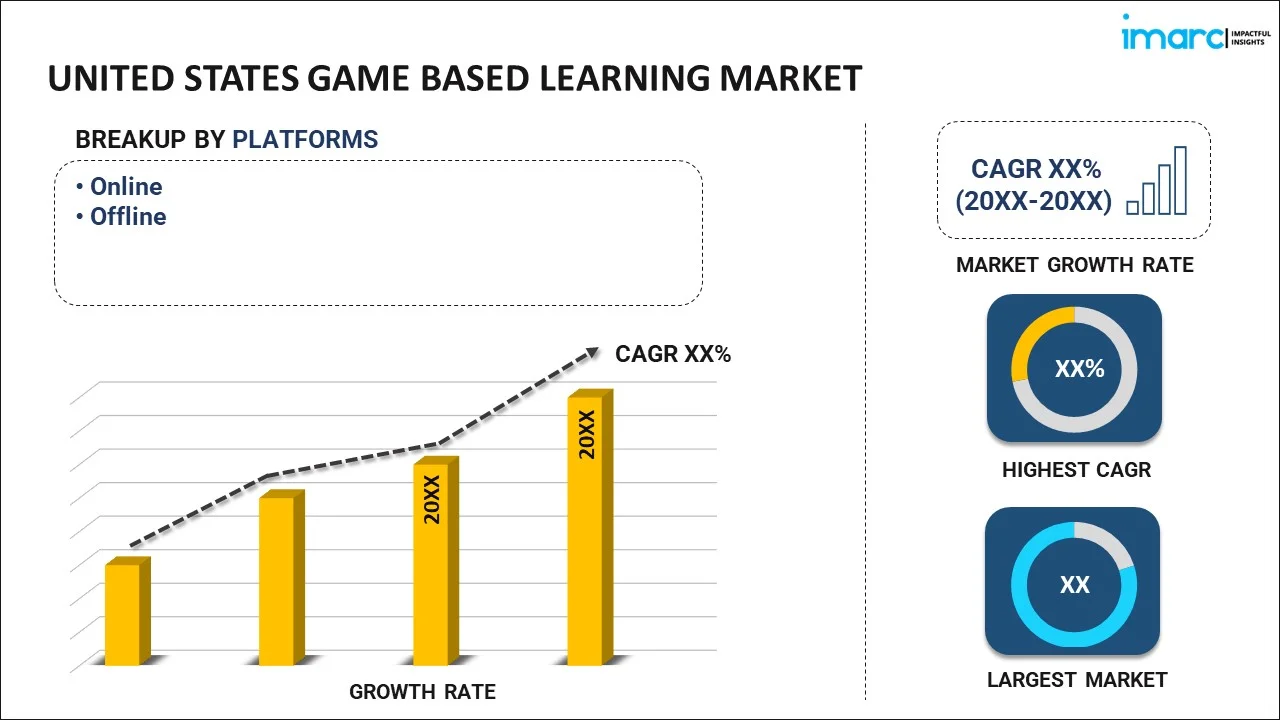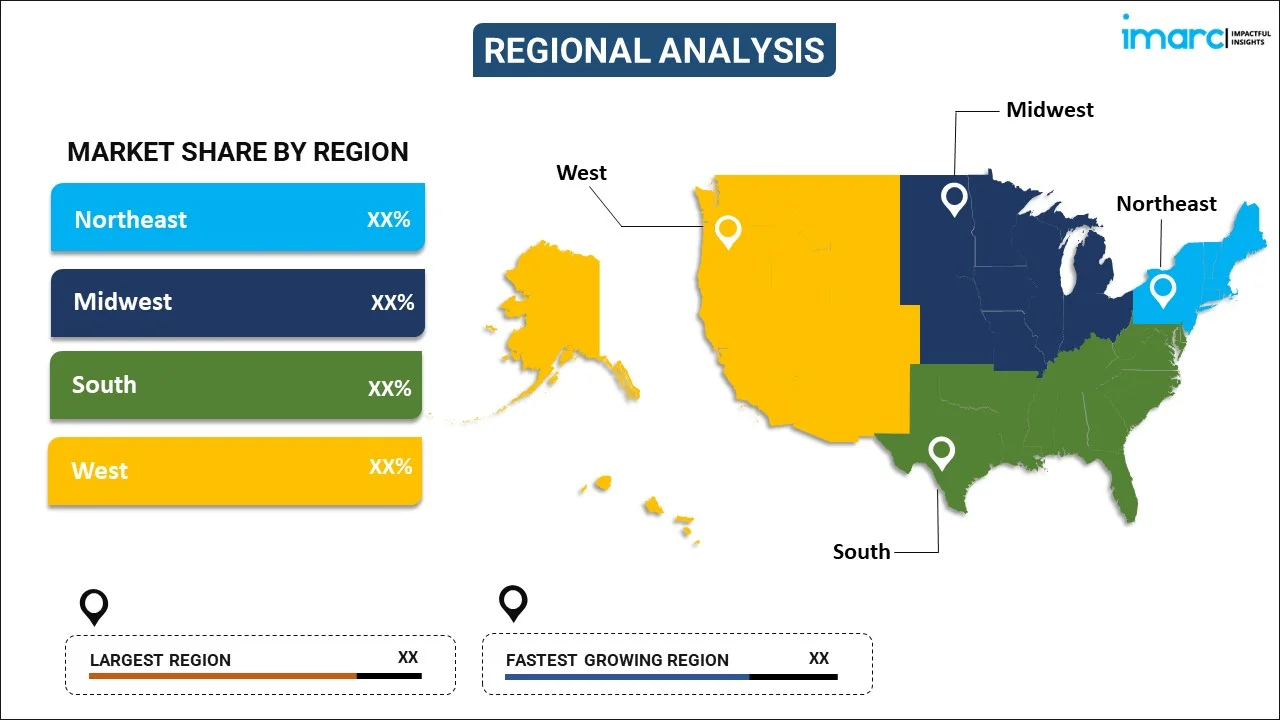
United States Game Based Learning Market Report by Platform (Online, Offline), Revenue Type (Game Purchase, Advertising, and Others), End User (K-12 Game-Based Learning, Higher Game-Based Learning), and Region 2024-2032
Market Overview:
The United States game based learning market size is projected to exhibit a growth rate (CAGR) of 18.00% during 2024-2032. The ongoing digital transformation in the education sector, various advances in technology, including augmented reality (AR), and virtual reality (VR) in the country, and rising parental support for GBL represent some of the key factors driving the market.
|
Report Attribute
|
Key Statistics
|
|---|---|
|
Base Year
|
2023 |
|
Forecast Years
|
2024-2032
|
|
Historical Years
|
2018-2023
|
| Market Growth Rate (2024-2032) | 18.00% |
Game-based learning (GBL) is an educational approach that incorporates elements of games and game design into the learning process. It is a pedagogical method that leverages the engagement, motivation, and interactive nature of games to enhance learning outcomes across various subjects and skills. In GBL, educational content is presented in the form of games or gamified activities, making learning enjoyable and effective. Games provide immediate feedback on learners' actions and decisions. This feedback loop allows learners to understand the consequences of their choices and make improvements. Additionally, assessment can be integrated into the game to measure progress. GBL also covers a wide range of subjects and skills, from mathematics and science to history, languages, and soft skills like problem-solving, critical thinking, and teamwork. Examples of GBL include educational video games, simulations, quizzes, puzzles, escape rooms, and gamified apps or platforms used in both traditional and online learning environments. GBL has gained popularity in education due to its ability to make learning enjoyable, foster critical thinking skills, and improve retention of information. It is particularly effective in engaging younger learners, but its principles can be applied to learners of all ages, making it a valuable approach in modern educational settings.
United States Game Based Learning Market Trends:
GBL leverages the inherent engagement and motivation that games provide. It captures learners' interest, making the learning experience more enjoyable and effective. This engagement factor is a key driver for the adoption of GBL in both K-12 and higher education. In addition, the ongoing digital transformation in education, accelerated by the COVID-19 pandemic, has created a favorable environment for GBL. Schools and institutions are increasingly integrating technology into their teaching methods, making GBL solutions more accessible. Besides, advances in technology, including augmented reality (AR), virtual reality (VR), and interactive simulations, have expanded the possibilities for GBL. These technologies enhance the immersive and interactive aspects of game-based learning experiences. Moreover, the broader trend of gamification, which applies game elements and principles to non-gaming contexts, has influenced the adoption of GBL. Educators and organizations recognize the value of gamified approaches in boosting engagement and participation. Additionally, Collaboration between educational institutions, ed-tech companies, and game developers has resulted in the creation of high-quality GBL solutions, propelling the market. Furthermore, parental support for GBL has increased as parents recognize its educational benefits. This support extends to advocating for GBL implementation in schools and seeking out GBL resources for home learning.
United States Game Based Learning Market Segmentation:
IMARC Group provides an analysis of the key trends in each segment of the market, along with forecasts at the country level for 2024-2032. Our report has categorized the market based on platform, revenue type, and end user.
Platform Insights:

- Online
- Offline
The report has provided a detailed breakup and analysis of the market based on the platform. This includes online and offline.
Revenue Type Insights:
- Game Purchase
- Advertising
- Others
A detailed breakup and analysis of the market based on the revenue type have also been provided in the report. This includes game purchase, advertising, and others.
End User Insights:
- K-12 Game-Based Learning
- Higher Game-Based Learning
The report has provided a detailed breakup and analysis of the market based on the end user. This includes K-12 game-based learning and higher game-based learning.
Regional Insights:

- Northeast
- Midwest
- South
- West
The report has also provided a comprehensive analysis of all the major regional markets, which include Northeast, Midwest, South, and West.
Competitive Landscape:
The market research report has also provided a comprehensive analysis of the competitive landscape. Competitive analysis such as market structure, key player positioning, top winning strategies, competitive dashboard, and company evaluation quadrant has been covered in the report. Also, detailed profiles of all major companies have been provided.
United States Game Based Learning Market Report Coverage:
| Report Features | Details |
|---|---|
| Base Year of the Analysis | 2023 |
| Historical Period | 2018-2023 |
| Forecast Period | 2024-2032 |
| Units | Million US$ |
| Scope of the Report | Exploration of Historical and Forecast Trends, Industry Catalysts and Challenges, Segment-Wise Historical and Predictive Market Assessment:
|
| Platforms Covered | Online, Offline |
| Revenue Types Covered | Game Purchase, Advertising, Others |
| End Users Covered | K-12 Game-Based Learning, Higher Game-Based Learning |
| Regions Covered | Northeast, Midwest, South, West |
| Customization Scope | 10% Free Customization |
| Report Price and Purchase Option | Single User License: US$ 3699 Five User License: US$ 4699 Corporate License: US$ 5699 |
|
Post-Sale Analyst Support |
10-12 Weeks |
| Delivery Format | PDF and Excel through Email (We can also provide the editable version of the report in PPT/Word format on special request) |
Key Questions Answered in This Report:
- How has the United States game based learning market performed so far and how will it perform in the coming years?
- What has been the impact of COVID-19 on the United States game based learning market?
- What is the breakup of the United States game based learning market on the basis of platform?
- What is the breakup of the United States game based learning market on the basis of revenue type?
- What is the breakup of the United States game based learning market on the basis of end user?
- What are the various stages in the value chain of the United States game based learning market?
- What are the key driving factors and challenges in the United States game based learning?
- What is the structure of the United States game based learning market and who are the key players?
- What is the degree of competition in the United States game based learning market?
Key Benefits for Stakeholders:
- IMARC’s industry report offers a comprehensive quantitative analysis of various market segments, historical and current market trends, market forecasts, and dynamics of the United States game based learning market from 2018-2032.
- The research report provides the latest information on the market drivers, challenges, and opportunities in the United States game based learning market.
- Porter's five forces analysis assist stakeholders in assessing the impact of new entrants, competitive rivalry, supplier power, buyer power, and the threat of substitution. It helps stakeholders to analyze the level of competition within the United States game based learning industry and its attractiveness.
- Competitive landscape allows stakeholders to understand their competitive environment and provides an insight into the current positions of key players in the market.
Need more help?
- Speak to our experienced analysts for insights on the current market scenarios.
- Include additional segments and countries to customize the report as per your requirement.
- Gain an unparalleled competitive advantage in your domain by understanding how to utilize the report and positively impacting your operations and revenue.
- For further assistance, please connect with our analysts.
 Inquire Before Buying
Inquire Before Buying
 Speak to an Analyst
Speak to an Analyst
 Request Brochure
Request Brochure
 Request Customization
Request Customization




.webp)




.webp)












